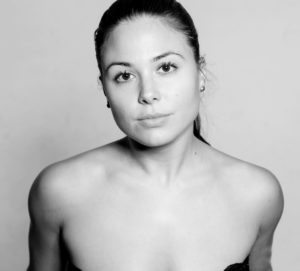Prized Solo: Feminist work Pour yields rewards for choreographer Daina Ashbee and dancer Paige Culley - Vancouver Ballet Society
- Home
- Features 2015 - 2019
- Prized Solo: Feminist work Pour yields rewards for choreographer Daina Ashbee and dancer Paige Culley

By Tessa Perkins Deneault
In 2016, Daina Ashbee was awarded the Prix Découverte de la danse for her solo, Pour, which premiered in Montreal at La Chapelle. The following year, Paige Culley performed Pour at Festival TransAmériques and received the same award for her interpretation of Ashbee’s choreography.
The awards, part of the annual Prix de la danse de Montréal, consist of $5,000 and a one-week creative residency. Culley plans to use the residency to work on her personal practice. “I’m curious about developing what my sense of making dance is without being in correlation with another artist,” she says.
Culley, who trained at the School of Toronto Dance Theatre and was a member of Compagnie Marie Chouinard for five years, is currently a freelance artist. She first worked for Ashbee in 2011, performing in Unrelated. The opportunity to tackle Pour, a challenging nude solo, “came at a time when I was looking for a challenge.”

She had gained some experience dancing nude with Chouinard’s company, although in a group setting and often with low lighting. After taking a workshop with Austrian Doris Uhlich and appearing in Uhlich’s More than Naked, Culley became more comfortable in her skin, first during rehearsals and then in a performance that had 20 dancers wiggle their flesh, slap their bodies against each other and shake to the beat as Uhlich served as an onstage DJ.
Culley’s perspective on nudity in dance shifted to something that is safe and not necessarily sexually loaded. Referencing choreographer Daniel Léveillé’s philosophy that full nudity actually erases the sexuality associated with the body, Culley explains that she now views nudity as simply another way to costume a dancer that conveys a great deal about the choreography.
Since its Montreal premiere, Pour has toured across Canada to Vancouver, as well as to France, Finland, Spain and the Czech Republic. The work has been received positively, says Culley, although it places an intense demand on the audience due to its confrontational nature, use of repetition and slow build-up to seemingly painful movements as Culley writhes around on the floor, slaps her limbs on the stage, and screams in anguish and exasperation. Many viewers perceive Pour as violent and have asked during talkbacks why Culley was hurting herself onstage, but she said that, while the piece has its physical demands, it’s no more painful than any other work she’s performed. On the contrary, Culley finds the piece to be empowering and even playful.
This contrast between suffering and empowerment is intentional as Ashbee presents bodies in ways that subvert commonly held beliefs and assumptions.
“People say they feel the work is honest, especially women,” says Culley. Men, she says, often think they’re not getting it as they’re unsure how to look at a naked female body as something other than an object of sexual desire.
Ashbee, of Cree, Métis and European ancestry, has had her work, which tackles subjects including female sexuality, Métis identity and environmental issues, performed at festivals around the world. She is the artist-in-residence at Montreal’s Agora de la danse until 2020, as well as an associate artist of Centre Création O Vertigo.
Pour places the naked performer in stark, bright light. It consists largely of simple movements, slow moving and held for a very long time. Ashbee explained at a talkback during the 2018 PuSh International Performing Arts Festival in Vancouver that the solo was originally inspired by the menstrual cycle’s intense emotions and transformations. She first imagined there would be blood on the stage, but realized blood was unnecessary and the choreography itself could evoke the pain of the female experience she wanted to represent.

Photo: Daina Ashbee
Culley sees the work as feminist in many ways. “A lot of it is loaded just in the fact that I’m exposing my body to be looked at,” she says, explaining that her body is presented in a raw way that is not meant to be beautiful. “The work is feminist in that it does play on the border between a body that’s often seen as sexualized and the idea of what my body should look like as a young woman.”
Culley and Ashbee, true collaborators, have much in common: both are in their mid-twenties and moved to Montreal from British Columbia, and, more importantly, they share a passion for confrontational, feminist works of art.

